 OK, before I talk about how seeing The Cremaster Cycle straight through changed my understanding of Matthew Barney’s work, let me get a couple of things out of the way:
OK, before I talk about how seeing The Cremaster Cycle straight through changed my understanding of Matthew Barney’s work, let me get a couple of things out of the way:
1) FLW didn’t design those theater chairs to be sat in at all, much less for eight hours in one day Aggressive, non-user-centered architecture should be taken out and shot.
2) Best overheard comment after Cremaster 1, when a guy at a suddenly partially visible urinal complained that the mens room door was being propped open by the line: “We just spent 45 minutes in someone’s ovaries. I’m sure no one cares about seeing you take a piss.”
3) I don’t know what country you’re from, and frankly, I don’t care. On this island, we keep our hands off the freakin’ art, especially when there are signs and guards at every piece. And if you pull the dumb foreigner shtick every time a guard tells you not to touch something, I’ll bust you again.
3.1) I swear, between this show and the MoMA QNS opening, I may never loan anything I own to a museum again.
3.2) What really makes me mad, is that now I’m all jingoistic, when I should just be anti-B&T. Oy, the world we live in…
 Net net: Matthew Barney’s films are worth seeing, again, and in order. They’re the strongest expression of what he’s doing. He may call himself a sculptor, but that’s just a numbers game. He clearly exerts phenomenal time/effort/thought on materials, objects and spaces; but the experience of his sculptures pales to that of the films (and the experience of sculpture-in-film). Likewise, his drawings–which are small, precious, slight, almost invisible–get subsumed by their giant sculpted vitrines.
Net net: Matthew Barney’s films are worth seeing, again, and in order. They’re the strongest expression of what he’s doing. He may call himself a sculptor, but that’s just a numbers game. He clearly exerts phenomenal time/effort/thought on materials, objects and spaces; but the experience of his sculptures pales to that of the films (and the experience of sculpture-in-film). Likewise, his drawings–which are small, precious, slight, almost invisible–get subsumed by their giant sculpted vitrines.
An extremely useful/interesting educational aid is The Gospel Cremaster Cycle (According to Neville Wakefield), an exhaustive catalog/glossary which functions like an encyclopedia of Barney’s universe. It weighs like a hundred pounds, though, so plan be home when it ships; you don’t want to carry it back from the post office (or the Guggenheim, for that matter).
There are a few exceptions: I found the flags and banners interesting, and some metal objects (e.g., the Masonic tools from C3) are exquisite. The mirrored saddle is in a class by itself (yeah, there are at least two, but only one’s on exhibit). [An art market side note: I don’t know, but a significant number of the C3 work is large, institution-sized, and all “courtesy Barbara Gladstone Gallery,” almost as if it’s a showroom for out-of-town curators. All that’s missing is a “to the trade only” sign in the window.]
As for the photographs, which I’d liked best going in, most feel inexplicably lifeless compared to the films they came from. Barney can create absolutely stunning images, but they’re on film, where stunning often morphs into mesmerizing. It’s telling that while the photos reproduce very well, I could only find one image of a Barney vitrine online–from an auction report; even though they’re display cases, these non-filmic sculptures seem innoculated against reproduction.
 The films hold up very well, but as film-as-art, not art-as-film. Consecutive viewing (as opposed to the in order they were made) strengthens both their thematic/narrative and their visual impact. I was surprised to realize how many elements are from Barney’s own life/world/story; it was unexpectedly personal, as opposed to issue/metaphor-driven.
The films hold up very well, but as film-as-art, not art-as-film. Consecutive viewing (as opposed to the in order they were made) strengthens both their thematic/narrative and their visual impact. I was surprised to realize how many elements are from Barney’s own life/world/story; it was unexpectedly personal, as opposed to issue/metaphor-driven.
In his review, J. Hoberman says that the press screenings for the whole Cycle were sparsely attended; he (like everyone else, he concludes) prefers the ambient, less demanding mode of watching a few minutes on the gallery flatscreens. “One scarcely staggers from this six-and-a-half-hour magnum opus inclined to proclaim the second coming of David Lynch�or even Julian Schnabel,” he writes, in full “when you’re a hammer, everything looks like a nail” mode.
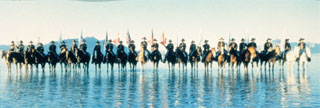 Which makes Barney’s claim to be a sculptor, not a filmmaker, relevant. He’s asserting his identity as an artist. Cremaster 2, which Hoberman slammed the hardest as a film, is one of the most haunting and beautiful works of art I’ve seen. Jeremy Blake told me Paul Thomas Anderson had asked him, “Man, why do artists have their heads so far up their asses sometimes?” “They like the smell,” Jeremy deadpanned. “But seriously, it’s introspection. Contemplation. You should try it sometime.”
Which makes Barney’s claim to be a sculptor, not a filmmaker, relevant. He’s asserting his identity as an artist. Cremaster 2, which Hoberman slammed the hardest as a film, is one of the most haunting and beautiful works of art I’ve seen. Jeremy Blake told me Paul Thomas Anderson had asked him, “Man, why do artists have their heads so far up their asses sometimes?” “They like the smell,” Jeremy deadpanned. “But seriously, it’s introspection. Contemplation. You should try it sometime.”
In my budding filmmaker mode, I had had some of the same complaints as Hoberman (ie., simplistic camera angles, AWOL editing), but his glib dismissal of Cremaster says more about the diminished expectations and limits of film. Sure, movie directors think they’re God, and Barney’s conjured up a complete, system of symbols and myths that’d make the Catholic Church proud. Whether that means he thinks he’s God, Jesus, or the Pope, I can’t say, but at least he isn’t the second coming of Julian Schnabel.
Category: art
It’s Cremaster Friday, Demonlover Saturday
I’m watching the entire Cremaster Cycle today, a Friday feature of the Guggenheim show. In the mean time, Matthew Barney’s site, Cremaster.net, is up and running. Check out the trailer; it’s beautiful. And it doesn’t take all day (unless you’re on a dialup).
In the mean time, brace yourself and go see Olivier Assayas’ Demonlover tomorrow at Lincoln Center’s Rendez-Vous with French Cinema series (or, if you insist, Rendez-vous with Freedom Cinema series. Assayas will be at the screeningNow who’s all PC?) Read about it in Film Comment, where Gavin Smith saw it at Cannes. Smith called it the best undistributed film of 2002. Assayas’ll be there. Order tickets online, if you can. Yesterday’s screening sold out++. Assayas was there yesterday, too, and we talked a bit about collaborating with anime studios, CG’ers, and Sonic Youth.
On Bar Codes And Profiling
 A NYT article about Cockeyed‘s great barcode hack, written by David F. Gallagher (the Lightning Field one, not the shirtless one. “F.” must stand for “fully clothed.” David, you have my sympathies. At least you’re going up against a real person. I’m still being out-Googled by an ad-agency caricature, an off-the-air bunny puppet, and a friend of Dharma, two if you count Greg Louganis.)
A NYT article about Cockeyed‘s great barcode hack, written by David F. Gallagher (the Lightning Field one, not the shirtless one. “F.” must stand for “fully clothed.” David, you have my sympathies. At least you’re going up against a real person. I’m still being out-Googled by an ad-agency caricature, an off-the-air bunny puppet, and a friend of Dharma, two if you count Greg Louganis.)
Rob Cockerham is distributing clones of his Safeway card online, thereby commenting on/thwarting the supermarket’s tracking him and and “his” purchases (which “he” now makes in stores all over the country, as far as Safeway knows, anyway).
Interesting that this article appears in the Times. Whenever I’m traveling and airdrop into a netcafe, or login to nytimes.com from someone else’s computer, I’ve always saved my login info on that machine. Over the years, I’ve wondered what the Times thought of my appearing in dozens of places at once. (They had enough, I guess; a few months ago, they started expiring their cookies after 30 days.)
Other barcode links: Peter Coffin’s Free Biennial art project, Scott Blake’s Barcode Art site [both via Wooster Collective] And in the view of many End Time pundits, barcodes are the “mark of the beast.” Left Behind’s 8th book was called The Mark, as this Australian
On Collecting Art, On Collecting Taxes
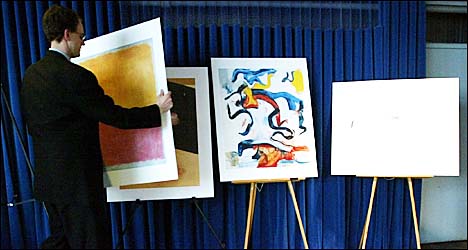
US Attorney/curator with posters of Rothko, Bacon, deKooning and either Twombly or Clemente,
purchased by Sam Waksal with an 8.25% discount, at least.
In the grand tradition of deposed CEO’s, but with downtown sensibility (and far better taste), Sam Waksal pleaded guilty to evading sales tax on $15 million in paintings he purchased through a major New York dealer. It was the old, “send it to my factory in NJ, nah, just fax the invoice there” ploy, which has been tripping up art world naifs since the 80’s, at least. (Clearly, it’s worth it to work it and get your 10% discount from the dealer instead.) Waksal’s lawyer tells the Washington Post that his client was “not the architect of the scheme.” Yow.
Since no report names all nine works involved, here it is, a greg.org exclusive:
That adds up to $14,960,000. Any guess what the last, $40,000 work could be? According to the Times, it’s Richard Serra. His sculptures can go for more than $1m, but $40k for a painting is doable. What’s more, these last three artists show with the Dealer. Waksal can brag about the sweet deal he got on them, all while paying the Dealer super-retail for what amounts to personal shopping.
[Update: The NYPost pegs Waksal’s total at $15.31 million, which means the Serra was $350,000. That sounds like Sam didn’t even get a discount on the in-house stuff. No wonder he’s fingering The Dealer. Update #2: Turns out the Serra was titled, The American flag is not an object of worship. Don’t let FoxNews get wind of that sale.]
Chelsea Gallery Shortlist
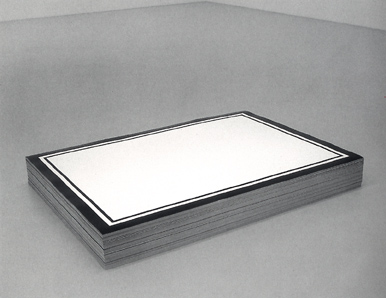
Untitled (Republican Years), Felix Gonzalez-Torres, 1992
currently in “Stacked” at D’Amelio Terras
If you are boycotting the French right now, you’re a loser. They’re putting on some of the best shows in town. Additions to an incomplete list:
On A Big Art Thursday
Last night at a friend’s house, Jeremy Blake showed us some recent work and talked about it.
The New Museum previewed a strong group show, “Living Inside the Grid,” where Dan Cameron exercises his international muscles in advance of the Istanbul Biennial. There are some obvious (and thus, intentional) omissions, but many nice pieces, including a creepy-sleek prison door by Elmgreen & Dragset.
And finally, while I didn’t make the opening, the after-party came to us at dinner: The Whitney opens a show about Diller + Scofidio, architects who have PR-muscled their way to the front of the technology/media stage. Eager to make amends for the dustup caused by his baldly partisan, king-making articles about the WTC redesign, the NYTimes‘ Herbert Muschamp returns to clear-eyed, of-the-people objectivity in his review. Here’s the first paragraph:
The search for intelligent life in architecture is artfully rewarded at the Whitney Museum’s retrospective of the work of Elizabeth Diller and Ricardo Scofidio, New York’s brainiest architectural team. But intelligent visitors will have to pick their way through a few unwelcome booby traps: curatorial winks and nods designed to dumb things down for the chimerical unsophisticates to whom far too many museum shows today are needlessly pitched.
On Museums On eBay
This AP story [via the cool Scrubbles.net] from Indianapolis sounds like the tip of the iceberg: museum curators using ebay to add to their collections.
My conversations about eBay with various curator friends all follow a predictable a trajectory: surprise that we’re both eBay whores; polite envy over what the other scored; caginess over what we’re looking for now; relief when we find out we’re looking for different stuff; quick detente and an exchange of usernames when we find out we’re buying the same stuff.
Of course, now eBay’s gonna turn my butt in to the Feds, as the EFF reports they’re all too eager to do.
On Wooster Collective
As I arrived at Gawker’s launch party last week, I ran into some friends from my old consulting days. (I guess it’s Nick’s job to know everybody, and he does.) Anyway, their shoutout just before the elevator door closed, “we have a weblog, Wooster Collective” should be nominated for Undersell Of The Year.
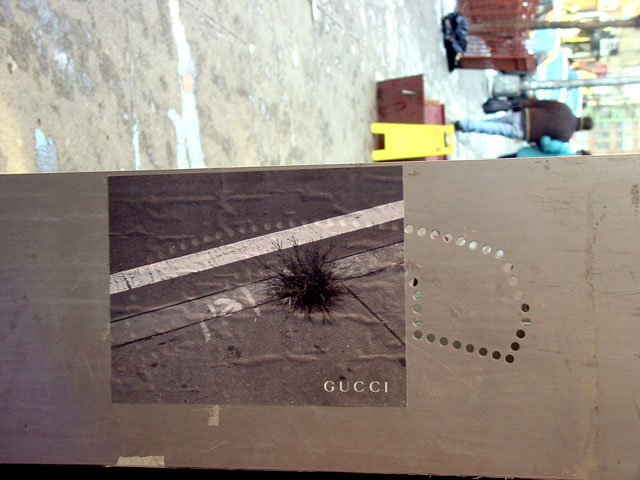
Wooster Collective is a hoppin’ arena of grafitti, stickers, stencil art and other street art, with updates coming more frequently than the 4-5-6 train at rush hour. In a remarkably short time, they’ve tapped into a sprawling network of artists and fans who contribute great stuff from far beyond Wooster.
Some highlights: Posters of sidewalks by Gucci, et al; Peter Coffin’s barcode stickers [Peter, you gotta tell me about this stuff…]; and Dan Witz interview, whose trompe l’oeil graf works are stunning.
As If greg.org Needed Another Matthew Barney Reference…

Yeah, I want a Cremaster belt buckle, but not if it means
getting executed in a salt arena… image: guggenheim.org
‘cuz it’s gonna be all we talk and hear about for months (at least until Matrix Reloaded comes out). We’re just suckers for an entirely fabricated, all-encompassing, and disturbing worldview. (What, the imagined world of Wolfowitz ain’t scary enough?)
Anyway, in the Times, Michael Kimmelman gets all sticky for the Cremaster show, which opens today at the Guggenheim. Note to all: Fridays through June 6, are hereby set aside for watching the entire 5-film Cycle, in order. You will be graded on this.
Note to MB: If Prada teaches the world anything, it’s to actually have a site up when you go wide with a marquee URL.
On Thomas Struth On Art
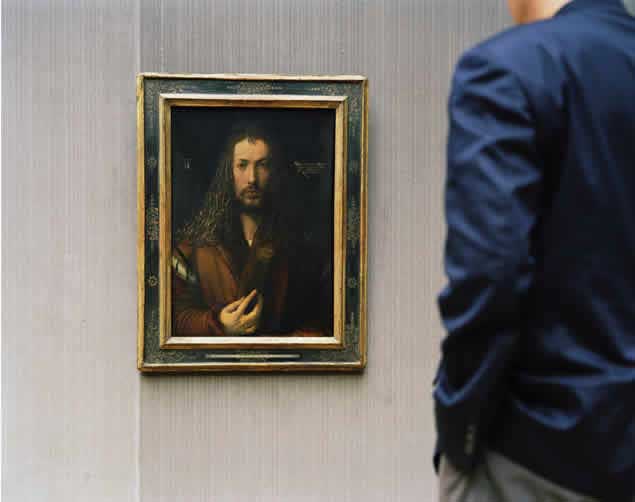
Alte Pinakothek, Selftportrait, Munich, 2000, Thomas Struth
The other night, I heard the photographer Thomas Struth talk about his work. A friend (who has a far more serious art habit than even I do) hosted a reception for the artist in his office. Extra Struths, brought out of storage for the evening, rested on stacks of printer paper, an installation technique you don’t see at the artist’s current one-man show at the Met.
Struth spoke very quietly, but determinedly, about his work and the ideas and process behind it. He’s clearly contemplative, and some of his most well-known works are unabashedly about contemplation (his Paradise junglescapes and his photos of museumgoers). He described his decades-long relationship with the 1500 self-portrait of Albrecht Durer (above) and his fascination with its unusual gaze. By putting himself in the photo (that’s Struth’s shoulder), he wanted to capture a moment of a conversation, while readily allowing that the two figures may not be saying anything to each other.
He caught me off guard, though, by referring to the photo’s cinematic character; but sure enough, the framing, blocking and “sightlines” are from one half of a shot/reverse-shot, the continuity editing staple for depicting a two-person conversation. Struth wanted to portray a conversation that crosses 500 years (he shot it in 2000), a long-term perspective Struth finds shamefully absent today.
“No one [in the current political situation] looks forward even 50 years; they only look to their next election.” Struth then ruminated on art worlders and what they could do to pull the real world back from the brink of war. “We’re here, in the office of [one of the wealthiest men in the world], there are so many influential people in the art world. Why don’t people use this powerful social network” to avert this global disaster?
Nervous silence, nervous chatter, and then a spurt of panged/defensive hands, as a few people tried to explain how our “standing here sipping champagne” was actually alright. An older guy with a Palm Beach tan leaned over and murmured to me, “I think we’re going in the wrong direction.” “That’s exactly what he’s talking about,” I deadpanned, “Oh, you mean the conversation.” Soon, we returned, quickly, safely, and completely, to discussions of how, exactly, he was able to get that amazing shot of the Parthenon. (“Because I’ve tried to shoot it every time I go, and it’s just so dark!”)
One implication in Struth’s photo, which cannot be avoided, of course, is our own responsibility. Shot/reverse-shot technique uses two components to establish the shared space; a reverse shot is needed. It would be a shot of Struth (and all of us, in the present day, standing in museums and galleries and private collections) from the perspective of Durer’s painted space, maybe over the 16th-century artist’s shoulder, a shot looking far into the future.
See Christian Marclay’s Video Quartet at Paula Cooper By Saturday

Last night I heard the artist Christian Marclay talk about Video Quartet, his enchanting, mind-boggling music/film work at Paula Cooper Gallery. It’s a 13-minute musical composition of nearly 600 separate film clips, on four simultaneous channels, projected onto a 40′-long screen. It was commissioned by a friend, Benjamin Weil, a curator at SFMOMA, where it was shown last summer to wide acclaim. [Naturally, Jason Kottke wrote about it then; so did Wired.com.] Rather than parrot or try to outdo other reviews, or gush about my own experience (I’ve now seen Quartet ten+ times), I think it’s worthwhile to look at how Marclay actually made the piece.
Video Quartet owes its existence to the recent emergence of real desktop editing software, and the artist’s highly unconventional use of it. Amazingly, Marclay learned and used Final Cut Pro: “I sat in front of a computer for almost a full year,” he said. With the concept and an abstracted narrative structure in mind and starting with the films he knew, Marclay gathered scenes with music, performance, or sounds. He made bins for various categories (e.g., piano playing, singing, gongs, violins, tapdancing), hand-building a database of clips to work from.
Then he started constructing passages or scenes and built “bridges” between them. (One thing he said he’d wished he’d done differently: start at the beginning and build it sequentially. Hey, no complaints from me.) Along the way, Marclay would search out additional films and pull from them “the right combination of music and image.” (Musical strike two for Richard Gere: Marclay wanted to use Gere playing trumpet from The Cotton Club, but the combo just didn’t work.)
But how can you edit four video+audio channels in FCP, which plays multiple audio channels, (but only one video channel) at a time? By ear, apparently. He’d layer the four video+audio channels, set sound levels, and then adjust the timing of edits by outputting tiny animated versions, side by side. The result is exquisitely composed sound throughout, with absorbing images choreographed across four screens, flecked with just a touch of visual chance.
Knowing the basics of Marclay’s method adds a layer of complexity to Quartet, a layer that deepens with even a little hands-on experience in Final Cut. The last time I watched it, I began seeing the clips on a timeline, picturing a. What had seemed impossible or magic before was now revealing itself as a complex creation, the product of arduous, inspired effort.
Art Worth Crossing The Street For

Installation view, Anne Truitt, Danese Gallery (image:artnet.com)
Two shows of evocative new work by unrepentant minimalists are on 57th street at the moment, a moment when a pair of artists over 80 demonstrate the power and relevance of the minimalist mode, as well as the potential benefits of being in it for the long haul.
Yeah, Capitalism, or In Defense Of A Collector
 Also at Slate Joshua Clover writes a clever essay (very or too, depending on if those are exhibition posters or actual paintings on your wall) about Richter 858, a luxuriantly produced ode– in book form, with specially commissioned poems and a CD (of Richtermusik, I guess) — to a suite of Gerhard Richter squeegee paintings. Retailing at $125 and co-published by SFMOMA (who have been promised the paintings from an anonymous donor), Richter 858 is a “classic fetish item, beautiful enough that everyone might want it but priced beyond the reach of the great unfunded.” And that’s not the worst of it.
Also at Slate Joshua Clover writes a clever essay (very or too, depending on if those are exhibition posters or actual paintings on your wall) about Richter 858, a luxuriantly produced ode– in book form, with specially commissioned poems and a CD (of Richtermusik, I guess) — to a suite of Gerhard Richter squeegee paintings. Retailing at $125 and co-published by SFMOMA (who have been promised the paintings from an anonymous donor), Richter 858 is a “classic fetish item, beautiful enough that everyone might want it but priced beyond the reach of the great unfunded.” And that’s not the worst of it.
Clover reveals that 858‘s editor, David Breskin, is an SFMOMA Trustee and “almost certainly” the donor of the paintings, facts which–despite a year of SEC reforms and disclosure scandals–go unmentioned in the book. “Whatever a given Richter painting, or a particular poem, might be about, Richter 858 is about checkbooks and culture–that is, it’s a book perfect for decadent modernism, where the art of consumption has replaced the art of production; it’s a book, finally, about collecting, that individualist art overseen by the twin muses ‘Dollars’ and ‘Indulge.'”
“Dollar”: Last time I checked, what a Richter painting’s about, is $400,000 – 1 million, depending on the size and the date. A suite of eight, then, is about, well, you do the math. By making the paintings a “fractional and promised gift” to the museum, our benefactor (let’s call him “DB”) gives a percentage of the title each year for a fixed term ( ex. 10%/year, 10 years), until they belong 100% to the museum. Why do this, O Muse?. “DB” spreads a large tax deduction out over several years, which is useful if his gifts exceed 30% of his adjusted gross income. “Indulge”: “DB” is able to keep the art for a period of time each year in proportion to his percentage ownership.
But there’s another muse’s fingerprints on this one. 858‘s not a catalog, it’s an experience Compared to the essay- and information-packed Richter exhibition catalog written by “The Brain,” (aka, former MoMA curator Robert Storr), Richter 858‘s multimedia melange is a work of the Heart.
“Heart”: SFMOMA says Breskin was “compelled by these works” to create this book. Talking about the project and his interactions with Richter, Breskin’s giddiness (“As a sequence, these hung together and swung in a musical sense,” “I wanted to create an alternative way of engaging with pictures.”) sounds less like a trustee and more like a groupie.
Trust me, that’s what some of the most passionate collectors are, art groupies. Going to concerts (openings), getting backstage (in the studio), obsessing over some lyric (work) and asking arcane questions that betray how powerfully a it inhabits your mind. Groupie? Check out Breskin’s 2-day interview with the Richter of 1987 rock-n-roll, Bono, for Rolling Stone. Breskin seems like the kind of guy–indulgent, clearly, but in a necessary way–who’s trying to live an art-centered life, not just an “art-owning” one. And by placing the Richters at SFMOMA, “DB” seems like the kind of donor who believes that indulgent art experience should always be available to the public (but who agonizes over letting the paintings go too soon).
And besides, 858‘s 30% off at Amazon. A serious collector looks for a discount.
Overview: Powerpoint as Creative Medium
Bright Glow Tube (all images, powerpointart.com)
Slide 1 – Background:
- Powerpoint invention and evolution (ref. Ian Parker’s May 28, 2001 New Yorker article)
- Powerpoint taking over human thought. 30 million presentations made daily. (ref. Julia Keller’s Chicago Tribune article today) [via Romenesko’s ObscureStore.com]
- Career spent making/giving Powerpoint presentations (ref. “where I worked)

Hay Theme
Slide 2 – What this will be used for: - As-Yet Unannounced Animated Musical (AYAUM)
- Wrest Human Creativity From Jaws of Monopolist Technology (TBD)
- Obligatory 3rd bullet point
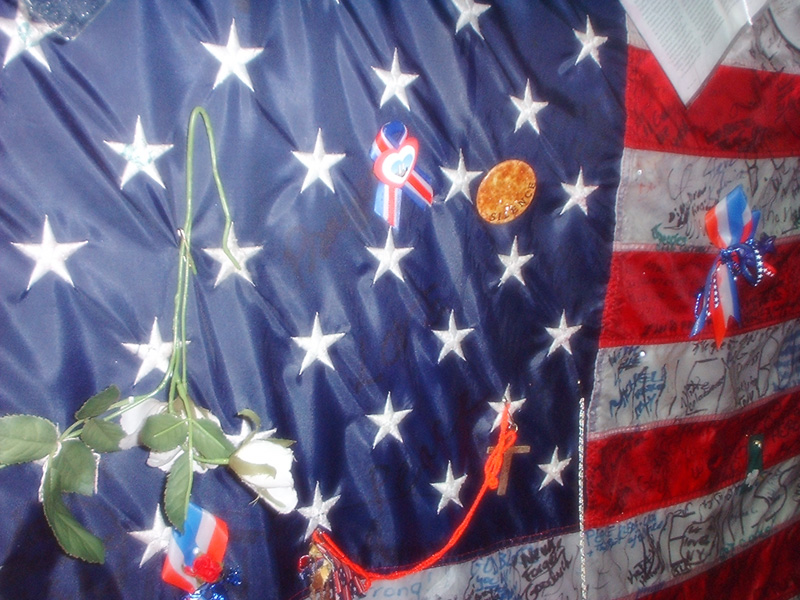 background image from powerpointart.com, wtc-memorial-us-flag.jpg
background image from powerpointart.com, wtc-memorial-us-flag.jpg
Slide 3 – Examples: - RTMark
- Powerpoint Gettysburg Address
- Relationship: An Analysis
- TBD
Slide 4 – Action Items: - Collect examples of Powerpoint as Medium
- Ask WWSD? (What Would Slate Do?)
- Adapt spychedelic Willie Wonka & The Chocolate Factory Oompa-Loompa text interludes into Powerpoint
Yinka Shonibare, Norton Christmas Project 2003


Dollhouse, Interior views, Yinka Shonibare
for the Norton Christmas Project 2002
In lieu of Christmas cards, the art collector Peter Norton and his family began sending out specially commissioned works. [Inspired by the Nortons’ example, we began commissioning artist editions–albeit at a much smaller scale–to send to family and friends as a commemmoration of various births and anniversaries.]
In 2002, the British/Nigerian artist Yinka Shonibare created a toy Victorian rowhouse, outfitted with his trademark Dutch batik fabrics, a photo of his own, and, for good measure, a Fragonard in the bedroom. Shonibare exhibited a sculptural installation based on Fragonard in 2001 and was in Documenta 11 last year.

Wink, Takashi Murakami, 2000
for the Norton Family Christmas Project 2000, image: Toyboxdx.com
For the 2000 Project, Jap-pop artist Takashi Murakami made a Wink doll, which contains a happy little CD in its base. Read about it on Alan Yen’s ToyboxDX. And in 1996, Norton asked Brian Eno to publish an updated edition of Oblique Strategies, his highly sought after collection of question and idea cards, originally made in collaboration with the late Peter Schmidt. Gregory Taylor’s OS site includes Norton’s description of the Project and soliciting Eno’s participation.
My favorite Strategy (as I attempt to write and edit in public): “Give the game away.”
